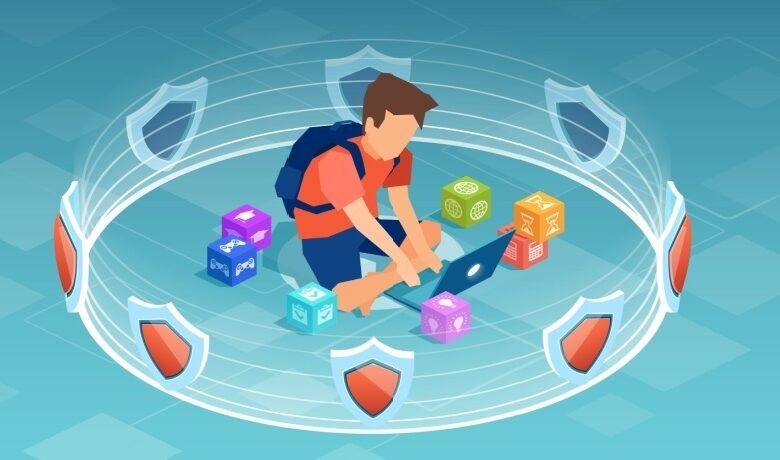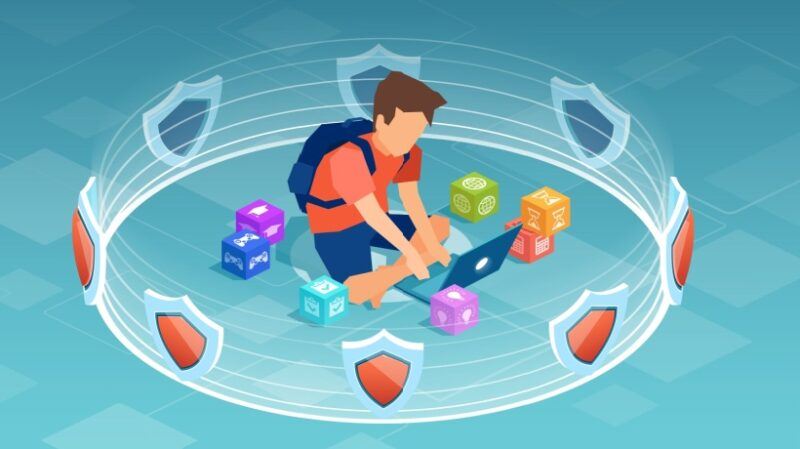Cybersecurity Basics You Can Share With Young Learners


What Are The Cybersecurity Basics Children Need To Know About?
It seems that nowadays, children are born tech wizards. They know how to handle smart devices almost naturally, as they have been surrounded by them almost since day one. However, the fact that they magically know how to turn on YouTube and play their favorite song doesn’t mean that they know anything about the rules of safe online behavior. So, what are the cybersecurity basics you need to teach young kids to ensure they are not put at risk while browsing the internet? Below, you will find some essential terms and best practices that are necessary for young online users to know.
What Is Cybersecurity?
First, you need to consider how to explain the general term of cybersecurity to young users. As adults, we know that cybersecurity is the practice of protecting our smart devices, networks, and data from unauthorized access. But how does that translate into a language a young audience understands? It’s best to approach this concept by breaking it down to its simplest definition. Namely, knowing the basic best practices of cybersecurity helps us protect ourselves in the virtual world. It is the digital equivalent of installing a strong lock on a door that keeps strangers out.
This is the basis of cybersecurity that can introduce kids to responsible online behavior. Let’s explore some more concepts and terms that they need to learn.
Cybersecurity Basics: Terms And Best Practices Children Should Learn
1. Types Of Dangers For Children
Before you start teaching children about the basics of cybersecurity, it is important to understand the types of threats they should be aware of. There are three danger categories children can come across while online. Let’s see what they are:
- Strangers – First, there are the threats related to complete strangers. These are the predators who will try to extract sensitive information from children by assuming fake identities or sending them suspicious links.
- Peers – Secondly, children may fall victim to online harassment, or cyberbullying, as it is most commonly known. This phenomenon often happens among peers, who can be strangers or acquaintances.
- Self – Finally, children can be a danger to themselves, especially when using the internet unsupervised for long periods of time. During that time, they can download malicious content or click dangerous links that could jeopardize their information.
2. Understanding Personal Information
Children often don’t understand the significance of protecting personal or sensitive information. For example, they frequently don’t know that while sharing your address with your friends at school is okay, you can’t do the same thing online. As the age of children who use social media platforms decreases, knowing which information can and cannot be shared is of utmost importance. Such information includes your full name, home or school address, phone number, etc. In the case of teenagers, banking information can be added to this list since online purchases come into play. Advise children never to share this information on their public profiles, where hackers, identity thieves, or other cybercriminals can access them.
3. Creating Strong Passwords
Children are finding themselves having to create personal online accounts for social media, gaming platforms, and, more recently, for their schools. Therefore, a basic cybersecurity best practice children need to learn is how to secure these accounts from unauthorized access. The first step is creating strong passwords. The general guidelines for passwords call for over 8 characters, combining letters, numbers, and symbols. For greater security, passphrases (a string of words in the place of a password) are being suggested for added security, as they are longer and harder to crack. Don’t neglect to advise kids never to share their passwords or passphrases, either online or offline.
4. Recognizing Phishing Attempts
Phishing is a tactic often used by cybercriminals to extract personal or financial information from unsuspecting parties by pretending they are a trustworthy person or company. It can happen through email, text messaging, phone calls, or websites, all of which are accessible to children. For instance, they might receive an email claiming they have won a prize or threatening to block their account if they don’t provide certain information. Teach young internet users to look out for the signs of a scam message, such as typos, suspicious language, and password requests. This way, children will learn to recognize phishing attempts and be less susceptible to them. Additionally, they will be more likely to ask for help from a trusted adult before clicking on anything.
5. Explaining Privacy Settings
Social media platforms, online games, and apps can become much safer for children if they know the basic cybersecurity practice of configuring their privacy settings. Most of these online platforms offer users the ability to control who can see their content. Walk young users through the process of making their accounts private so they can ensure that their posts are only visible to their friends and family and not everyone else. In addition to that, they should be mindful of who is on their contacts list. Remind children to only accept friend requests from people they know in real life. This way, their information will be less likely to fall into the wrong hands.
6. Logging Out Of Devices
It’s not uncommon for children to not understand the significance or even the concept of logging out of their online accounts. This is especially important since children often use shared devices, whether at home or school. Forgetting to log out can leave their accounts vulnerable to unauthorized access, which can result in anything from tampered files to identity theft and stolen credit card information. Therefore, they should always remember to hit “Log out,” especially on shared or public devices, as well as never check the “Remember me” box. This will ensure that their sensitive information or their parents’ banking details cannot be accessed by anyone else but them.
7. Practicing Safe Downloading
Children are often drawn to new apps, games, and software. Yet, they don’t always download from trusted sites where the content has been scanned for malware. Searching for their favorite video game that was just released can lead them to dodgy websites with malicious links. These can cause kids to inadvertently download viruses that might potentially harm not just the device itself but the entire network. Young users should be instructed to only download software or games from sites that they know and trust, preferably with the help of an adult. Moreover, they should be wary of free offers that could hide additional expenses or, worse, pose a threat to their system.
8. Talking To A Trusted Adult
A final cybersecurity best practice children must remember is that they don’t and can’t know everything themselves. On many occasions, they might need the help of an adult to ensure that the message they received is real or the website they are visiting can be trusted. Additionally, they might encounter online behavior that makes them uncomfortable and need help handling it. Therefore, they must have a trusted and knowledgeable individual to turn to whenever the need arises. This way, they will be able to navigate the virtual world responsibly without harming their mental health or compromising their safety.
Conclusion
In a world of constant connectedness, cybersecurity is a necessity for all online users, especially younger ones. As children grow up in the virtual world, they need to be empowered to navigate it safely by following a set of guidelines. In this article, we shared some cybersecurity basics that can be used to enforce responsible and safe online behavior. Make sure to keep communication channels open with children so they feel comfortable to ask for help whenever they are uncertain about their actions online.
Source link



